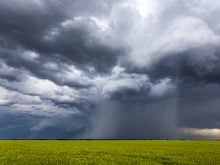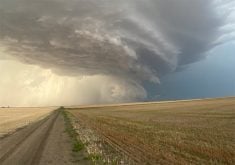It’s thunderstorm season, so let’s take a look at the topic.
Summer has moved in, so weather discussion across the Prairies turn to one of two topics: drought or thunderstorms. It’s too early to talk about drought, but with heat and humidity moving back into our region, thunderstorms become possible.
Let’s start with one of my weather pet peeves: when people mix up weather watches and weather warnings. A severe thunderstorm watch is issued when the potential exists for severe thunderstorms to occur but they have not yet formed. There may be thunderstorms around but none are severe.
Read Also

New coal mine proposal met with old concerns
A smaller version of the previously rejected Grassy Mountain coal mine project in Crowsnest Pass is back on the table, and the Livingstone Landowners Group continues to voice concerns about the environmental risks.
A severe thunderstorm warning means severe thunderstorms have developed and conditions have been recorded either directly by observers or by radar. When you hear a warning, you need to take immediate precautions.
Severe thunderstorm watches are typically issued when all the ingredients for severe storms are in place, but forecasters are not sure where, or sometimes even if, they will develop.
An analogy you can use is a pot of water on the stove. If you turn on an element and put on a pot of water, it will eventually boil, but where will that first bubble form and break away from the bottom of the pot? Will the heat stay on long enough for that bubble to form?
That’s like a thunderstorm. You know it is going to form but not exactly where.
What are the ingredients for severe thunderstorms? First you need rising air, and to get that you need heat, or rather, a large difference in temperature between two areas.
There are a couple of ways to achieve this difference. One is to have a very hot day, though just having a hot day does not mean a large difference in temperature. To get thunderstorms on a hot day, you need cool air aloft.
When this occurs, the hot air at the surface begins to rise and encounters cool air. The rising air will remain warmer than the air around it. The cooler the air around it, the faster it rises, and the faster it rises, the stronger the storm.
Sometimes we get severe thunderstorms without particularly warm air at the surface. Two different scenarios can play out when this happens, which can still lead to severe thunderstorms.
The first scenario is very warm air a few thousand feet up. This warm air has cold air above it, and just like the hot day on the ground, this warm air in the upper atmosphere can rise, giving us elevated thunderstorms.
The second scenario is when there is a strong contrast of warm and cool air at the surface, or in other words, some type of front is cutting through an area. On one side of the front it is cool, and on the other side it is warm.
The cold air, being heavier, acts like a wedge and forces the warm air up. Sometimes this occurs when a cold front is moving in, so the day starts off warm. Then the cold air pushes in, lifting the warm air up in front of it, giving us thunderstorms.
A big difference in temperatures, on its own, will not cause a thunderstorm, or at least not a severe one. There are a couple more ingredients needed.
One of them is water vapour or humidity. It takes energy to evaporate water and that energy is stored within the water vapour. So, the more water vapour there is in the air, the more energy there is.
As warm air rises, it cools, and as it cools, water vapour will begin to condense and release the energy it absorbed when it evaporated. The rising air is warmer than the air around it, so it rises even faster. Now almost everything is in place for a severe storm.
Eventually the amount of air accumulating at the top of the storm will become so great that it has to fall down, wiping out the storm in the process. But if there’s a vent at the top of the storm that removes the accumulated rising air, we have the key ingredients for a severe storm.
Daniel Bezte is a teacher by profession with a BA in geography, specializing in climatology, from the University of Winnipeg. He operates a computerized weather station near Birds Hill Park, Man. Contact him at daniel@bezte.ca.


















